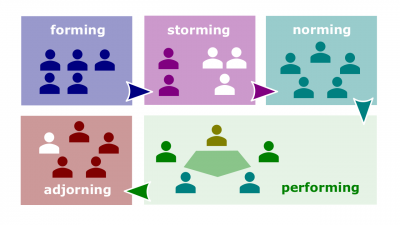Difference between revisions of "Group development"
(→Stages) |
|||
| Line 3: | Line 3: | ||
==Stages== | ==Stages== | ||
| − | #[[Forming stage]]. The first stage of | + | #[[Forming stage]]. The first stage of the ''Development'' in which people join the group and then define the group's purpose, structure, and leadership. |
| − | #[[Storming stage]]. The second stage of | + | #[[Storming stage]]. The second stage of the ''Development'', characterized by [[intragroup conflict]]. |
| − | #[[Norming stage]]. The third stage of | + | #[[Norming stage]]. The third stage of the ''Development'', characterized by close relationships and cohesiveness. |
| − | #[[Performing stage]]. The fourth stage of | + | #[[Performing stage]]. The fourth stage of the ''Development'' when the group is fully functional and works on group task. |
| − | #[[Adjourning stage]]. The fifth stage of | + | #[[Adjourning stage]]. The fifth stage of the ''Development'' for temporary groups during which group members are concerned with wrapping up activities rather than task performance. |
==Related lectures== | ==Related lectures== | ||
Revision as of 12:53, 18 December 2019
Group development (alternatively known as team development; hereinafter, the Development) is the learning model that depicts the process of developing a group.
Stages
- Forming stage. The first stage of the Development in which people join the group and then define the group's purpose, structure, and leadership.
- Storming stage. The second stage of the Development, characterized by intragroup conflict.
- Norming stage. The third stage of the Development, characterized by close relationships and cohesiveness.
- Performing stage. The fourth stage of the Development when the group is fully functional and works on group task.
- Adjourning stage. The fifth stage of the Development for temporary groups during which group members are concerned with wrapping up activities rather than task performance.
